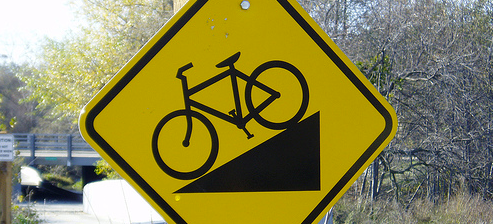WARNING: This post suggests you do dangerous things with a bicycle. Chances are your kid is going to do these things anyway, so make sure you help them do it safely. [I’m pretty sure my dad is the one who taught me to ghost ride…]
The saying goes, It’s like riding a bike, once you learn you never forget. People say that when they learn something complex, but mechanical: something they have to make an effort to learn, but soon becomes second nature (like riding a bike). Otherwise you’d spend all your time thinking about not crashing and forget to look at the flowers going by. But what does this mean? Is there something inherently memorable about riding a bike? Is muscle memory more or less permanent? Are our brains so complex that they can manage these tasks without us having to think about it?
What is muscle memory?
Muscle memory is when you become physiologically habituated, or used to, an activity like walking, picking your nose or riding a bike.
Although the precise mechanism of muscle memory is unknown, what is theorized is that anyone learning a new activity, or practicing an old one has significant brain activity during this time. The walking child is gradually building neural pathways that will give the muscles a sense of muscle memory. In other words, even without thinking, the child is soon able to walk, and the muscles are completely accustomed to this process. The child doesn’t have to tell the body to walk; the body just knows how to do it, largely because neurons communicate with the muscles and say, “walk now.” [Wise Geek]
Turns out that the bike doesn’t even need you
Ever ghost ride your bike? This is when you get your bike rolling down a soft grassy hill, and bail off letting the bike continue on without you. [WARNING: BE CAREFUL!] It doesn’t need your muscles or their memory to stay upright. Your bike will roll down the hill just fine without you and eventually crash as it looses forward speed. My friend John [see his account of driving a tiller ladder fire truck here] sent me this video of some geeky researchers have been studying how bikes can stay upright by themselves. Check out the video below:
Gyroscope
The video mentions gyroscope forces. While they proved that this doesn’t affect stability of a bicycle, it is an important concept to understand, so here it is.
Gyroscopic forces are created when a mass rotates around an axis. The tire and rim of a bicycle wheel are the mass and the axle where it attaches to the bike is the axis. The rotating mass has angular momentum which keeps it in place. Inertia is the tendency of moving masses to resist changes in their motion. So if a bicycle wheel is rotating it tends not to want to turn. This doesn’t matter much, as the video above proves, to riding a bike, but it is what keeps a gyroscope seemingly defying gravity.
[youtube]http://www.youtube.com/watch?v=cquvA_IpEsA[/youtube]The gyroscope in the video is a heavy metal mass around a light structure and axle. A bike wheel is a light mass rotating a light mass. If the bike tire were filed with something heavy, like ketchup, it would have more angular momentum and the inertia would make it behave much more like the gyroscope. Still, you can do the gyroscope trick with a bicycle wheel, just be careful not to get your finger caught in the spokes.
Fun with Gyroscopes and Bikes
So the take home message here is that riding bikes is fun, ghost riding is fun [BE CAREFUL] and gyroscopes are fun. So go have fun!
-Mike
[jcolumns] [jcol/] [jcol/] [/jcolumns]Sources:
- NPR Science Friday
- Wise Geek
- Wikipedia: Gyroscope, Angular Momentum, Inertia














Bike finishes race without rider 🙂
Bike finishes race without rider 🙂
That’s awesome Steve! Thanks for posting!
-Mike
That’s awesome Steve! Thanks for posting!
-Mike